Alaska 1991
What follows are some photographs from a trip I took to Alaska in the Summer of '91. As is not uncommon in Alaska at that (or any other) time of the year it rained a lot so I don't have as many breathtaking mountain vistas as I might wish. Nevertheless, the scenery is spectacular (when you can see it) and the wildlife plentiful in many areas.
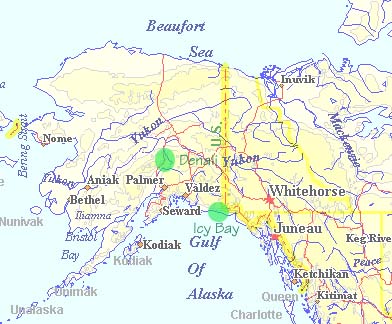 My trip and these photographs are from two distinctly different locales in Alaska, the southeast and Denali as shown on the map to the left. It's a bit of a hike to get most places in Alaska since roads and commercial airports are few. Anchorage is a major international airport and is easy to get to but it's the exception. The first leg of this trip involved a flight to the state capital, Juneau, from Seattle and via several of the smaller towns down the southeast coast and from there on to Yakutat, a commercial fishing village with a small airport, the following morning.
My trip and these photographs are from two distinctly different locales in Alaska, the southeast and Denali as shown on the map to the left. It's a bit of a hike to get most places in Alaska since roads and commercial airports are few. Anchorage is a major international airport and is easy to get to but it's the exception. The first leg of this trip involved a flight to the state capital, Juneau, from Seattle and via several of the smaller towns down the southeast coast and from there on to Yakutat, a commercial fishing village with a small airport, the following morning.
In spite of being the state capital, Juneau's a small town by the standards of most places with most of the "downtown" activity clustered around the waterfront where the cruise ships come in. It's also unique as a state capital in that it's surrounded by water with no road access. Coupled with southeast Alaska's foggy and rainy weather this makes it a somethimes difficult spot to get in and out of. I have to confess that I personally find the concept of sticking our legislators out on an island that they can't get on and off of easily an attractive concept for much government. In Massachusetts, for example, it would seem that profitable use could be made of Deer Isle for such a purpose -- but I digress.
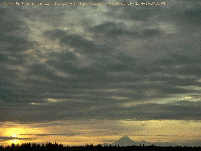 Mt. St. Elias and the coastal range from Yakutat - 800x600, 24-bit JPEG. Mount St. Elias which at 18,008 feet is the third highest summit in North America is part of a spectacular and enormous collection of mountains in and around the boundaries of Wrangell-St. Elias National Park. A huge network of glaciers flow from these mountains. One such glacier, the Malaspina Glacier, is larger than Luxembourg or Rhode Island. Some of the photographs which follow this one show just a hint of the glacial fingers which extend from the inland ice fields to the coastal bays. Unfortunately, this photograph is about it for the mountain views in southeast Alaska. For the rest of my travels in the area, the peaks nestled snugly in the clouds.
Mt. St. Elias and the coastal range from Yakutat - 800x600, 24-bit JPEG. Mount St. Elias which at 18,008 feet is the third highest summit in North America is part of a spectacular and enormous collection of mountains in and around the boundaries of Wrangell-St. Elias National Park. A huge network of glaciers flow from these mountains. One such glacier, the Malaspina Glacier, is larger than Luxembourg or Rhode Island. Some of the photographs which follow this one show just a hint of the glacial fingers which extend from the inland ice fields to the coastal bays. Unfortunately, this photograph is about it for the mountain views in southeast Alaska. For the rest of my travels in the area, the peaks nestled snugly in the clouds.
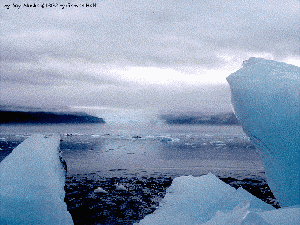 Glacier and calved ice in Icy Bay - 800x600, 24-bit JPEG. From Yakutat, I traveled with a group from Alaska Discovery by bushplane to Icy Bay. Over the next 10 days, our group traveled around the perimeter of Icy Bay in double Klepper folding kayaks, spending our days in a mixture of kayaking and day hikes into the surrounding hills. The glaciers themselves were nver silent with the ice constantly shifting and cracking. The huge blocks of ice on the beach here are just a small portion of the masses of ice filling the bay. The grounded ice was very useful in one respect; it went well with evening cocktails -- 300 year-old ice in 12 year-old Bourbon.
Glacier and calved ice in Icy Bay - 800x600, 24-bit JPEG. From Yakutat, I traveled with a group from Alaska Discovery by bushplane to Icy Bay. Over the next 10 days, our group traveled around the perimeter of Icy Bay in double Klepper folding kayaks, spending our days in a mixture of kayaking and day hikes into the surrounding hills. The glaciers themselves were nver silent with the ice constantly shifting and cracking. The huge blocks of ice on the beach here are just a small portion of the masses of ice filling the bay. The grounded ice was very useful in one respect; it went well with evening cocktails -- 300 year-old ice in 12 year-old Bourbon.
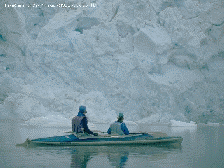 Kayak at foot of Glacier in Icy Bay - 800x600, 24-bit JPEG. Perhaps the only way to get a true sense of scale of the glaciers feeding inlets such as Icy Bay is to approach them (not too) closely in a small boat. You have to be somewhat cautious since the glaciers are always calving with huge blocks of ice falling into the water and kicking up significant waves and swells. (These kayakers aren't really as close as they may appear since this was shot with a telephoto.) The size is even more impressive when you consider that these are but the smallest outlying fingers of the huge inland ice sheets such as the Bering Glacier.
Kayak at foot of Glacier in Icy Bay - 800x600, 24-bit JPEG. Perhaps the only way to get a true sense of scale of the glaciers feeding inlets such as Icy Bay is to approach them (not too) closely in a small boat. You have to be somewhat cautious since the glaciers are always calving with huge blocks of ice falling into the water and kicking up significant waves and swells. (These kayakers aren't really as close as they may appear since this was shot with a telephoto.) The size is even more impressive when you consider that these are but the smallest outlying fingers of the huge inland ice sheets such as the Bering Glacier.
The glaciers in Icy Bay are currently retreating. The not so up-to-date NOAA charts of the area actually showed our campsite one night as being under a glacier. Along the shoreline, you could find encrusted shells left behind by the retreating glaciers (as well as burn wood similarly left behind in a campfire).
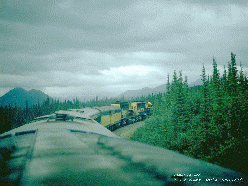 Alaska Railroad heading north to Denali - 800x600, 24-bit JPEG. From Icy Bay, a bushplane flight brought me back to Yakutat and a commercial flight onto Anchorage on the south coast of the state. Anchorage is a fairly young city -- only about 75 years old. Like the town in the Southeast, but on a larger scale, most of the tourist-type hustle and bustle is clustered near the waterfront for the benefit of the cruise ships. Outside this area, the city spreads out considerably with a decent smattering of parks and bike paths. Ultimately, however, Anchorage is a fairly conventional small city and, besides catching a good meal or two, most of the interesting activities involve heading elsewhere.
Alaska Railroad heading north to Denali - 800x600, 24-bit JPEG. From Icy Bay, a bushplane flight brought me back to Yakutat and a commercial flight onto Anchorage on the south coast of the state. Anchorage is a fairly young city -- only about 75 years old. Like the town in the Southeast, but on a larger scale, most of the tourist-type hustle and bustle is clustered near the waterfront for the benefit of the cruise ships. Outside this area, the city spreads out considerably with a decent smattering of parks and bike paths. Ultimately, however, Anchorage is a fairly conventional small city and, besides catching a good meal or two, most of the interesting activities involve heading elsewhere.
My goal was to get up to Denali as quickly as possible but during the short Alaskan tourist season, reservations can be tough. (I was staying at one of the few lodges inside the park, so reservations were particularly difficult.) As a result, I spent an afternoon whitewater rafting on the Matanuska before heading up to Denali. Full disclosure compels me to say that I actually just took the train back from Denali to Anchorage; the van going up was faster and synchronized with the busses going into the park.
The Alaska Railroad runs between Seward, Anchorage, and Fairbanks. It is one of only two railway lines in Alaska, the other being a narrow gauge between Skagway and Whitehorse, B.C. near the course of the Chilkoot Trail in Southeast Alaska. The Alska Railroad trip between Anchorage and Denali is a bit slow as it involves a great deal of elevation change but it's a neat trip if you like trains with great mountain views from the observation cars and much nicer dining cars than the Amtrak standard. The cruise ship companies hook up their own fancy rail cars but even the standard ones are quite nice.
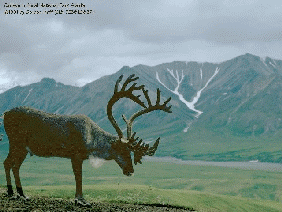 Caribou in Denali National Park - 640x480, 24-bit JPEG.From the entrance gates at Denali, buses take you into the interior of the park. (Private cars are only allowed in a little ways as far as the campgrounds near the entrance.) This is an excellent reason to stay in the interior of the park, whether at one of the few lodges in the interior or backpacking since buses making a round trip can only get partway into the park. Therefore, you're staying at the crowded entrance (or even just coming up from Anchorage for the day -- double yuck) and basically just taking a quick sightseeing tour into the park. This does not constitute seeing the park properly. (You're also unlikely to get the sort of views of Denali shown below since these views can really only be obtained from deep in the park and even there, only irregularly.)
Caribou in Denali National Park - 640x480, 24-bit JPEG.From the entrance gates at Denali, buses take you into the interior of the park. (Private cars are only allowed in a little ways as far as the campgrounds near the entrance.) This is an excellent reason to stay in the interior of the park, whether at one of the few lodges in the interior or backpacking since buses making a round trip can only get partway into the park. Therefore, you're staying at the crowded entrance (or even just coming up from Anchorage for the day -- double yuck) and basically just taking a quick sightseeing tour into the park. This does not constitute seeing the park properly. (You're also unlikely to get the sort of views of Denali shown below since these views can really only be obtained from deep in the park and even there, only irregularly.)
Along with the high peak views, the adundant wildlife makes dealing with the logistical difficulties in Denali all worthwhile. This Caribou was one of a group near the Eielson Vistor Center about halfway up the road from the park entrance to Kantishna in the park interior (near Wonder Lake). I like the way the Caribou's antlers mimic the patterns of snow and ice in the background mountain.
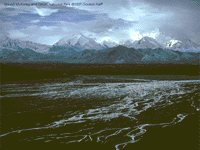 .
. 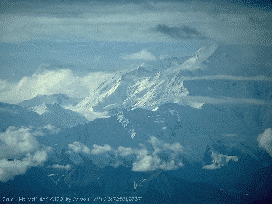 .
.
Mt. McKinley above glacial rivers, Denali National Park - 800x600, 24-bit JPEG and Mt. McKinley from above Kantishna Roadhouse - 800x600, 24-bit JPEG. Many visit Denali National Park hoping fervently to see a clear view of the highest summit in North America and come away disappointed. The weather is as unreliable in Denali as elsewhere in Alaska and views are occasional and short-lived. The first of these views is from the road somewhere in the park interior with Denali and nearby summits on the skyline above a complex mass of glacial streams. The closeup was shot from Wickersham Dome above Wonderlake and Kantishna. On my return from this hike about 30 minutes later, heavy fog eclipsed views of anything more than about 25 feet away.
This sort of changeable weather is one of the reasons that Mt. KcKinley (Denali) has one of the highest death tolls of any mountain in the world; higher than many of the 8000 meter Himalayan peaks.
Alaska is a huge state with stark contrasts from ocean to mountain to tundra to town and there is much I would still like to explore there. Perhaps on some fuuture date, I shall return and add further to this photography exhibition. In the meantime, Philip Greenspun's Travels with Samantha is a wonderful web-based acount of a few months which Philip spent in Alaska with photographs and writing. In the more traditional hardcopy variety, I have enjoyed James Michener's Alaska and John McPhee's Coming Into the Country. Joe McGuiness' Going to Extremes is still another book on the "Alaskan experience" but I personally found it kind of whiney (I don't think the author really liked Alaska much).
 Return to main photography page
Return to main photography page
 Send mail to Gordon Haff.
Send mail to Gordon Haff.
 My trip and these photographs are from two distinctly different locales in Alaska, the southeast and Denali as shown on the map to the left. It's a bit of a hike to get most places in Alaska since roads and commercial airports are few. Anchorage is a major international airport and is easy to get to but it's the exception. The first leg of this trip involved a flight to the state capital, Juneau, from Seattle and via several of the smaller towns down the southeast coast and from there on to Yakutat, a commercial fishing village with a small airport, the following morning.
My trip and these photographs are from two distinctly different locales in Alaska, the southeast and Denali as shown on the map to the left. It's a bit of a hike to get most places in Alaska since roads and commercial airports are few. Anchorage is a major international airport and is easy to get to but it's the exception. The first leg of this trip involved a flight to the state capital, Juneau, from Seattle and via several of the smaller towns down the southeast coast and from there on to Yakutat, a commercial fishing village with a small airport, the following morning. Mt. St. Elias and the coastal range from Yakutat - 800x600, 24-bit JPEG
Mt. St. Elias and the coastal range from Yakutat - 800x600, 24-bit JPEG Glacier and calved ice in Icy Bay - 800x600, 24-bit JPEG
Glacier and calved ice in Icy Bay - 800x600, 24-bit JPEG Kayak at foot of Glacier in Icy Bay - 800x600, 24-bit JPEG
Kayak at foot of Glacier in Icy Bay - 800x600, 24-bit JPEG Alaska Railroad heading north to Denali - 800x600, 24-bit JPEG
Alaska Railroad heading north to Denali - 800x600, 24-bit JPEG Caribou in Denali National Park - 640x480, 24-bit JPEG
Caribou in Denali National Park - 640x480, 24-bit JPEG

 Send mail to Gordon Haff
Send mail to Gordon Haff